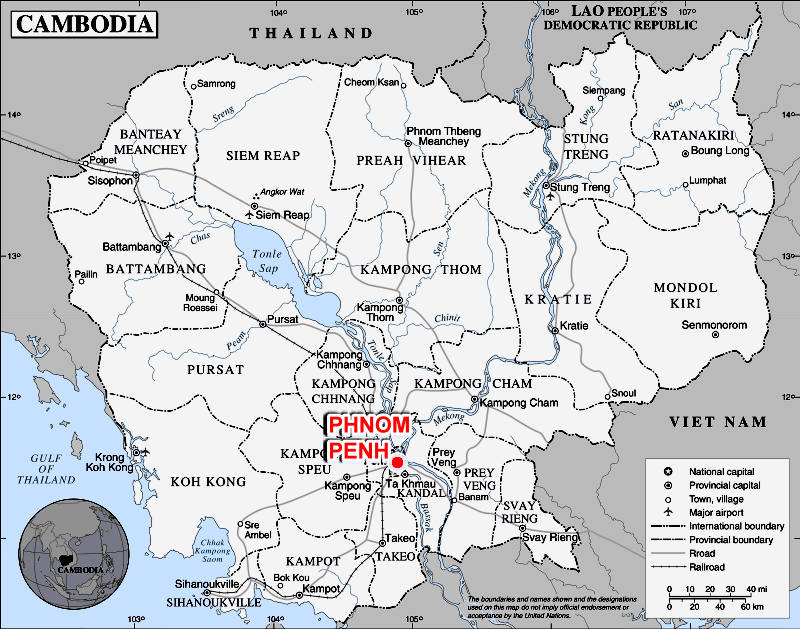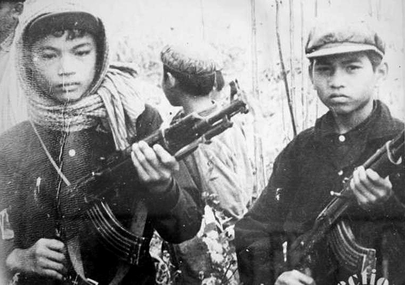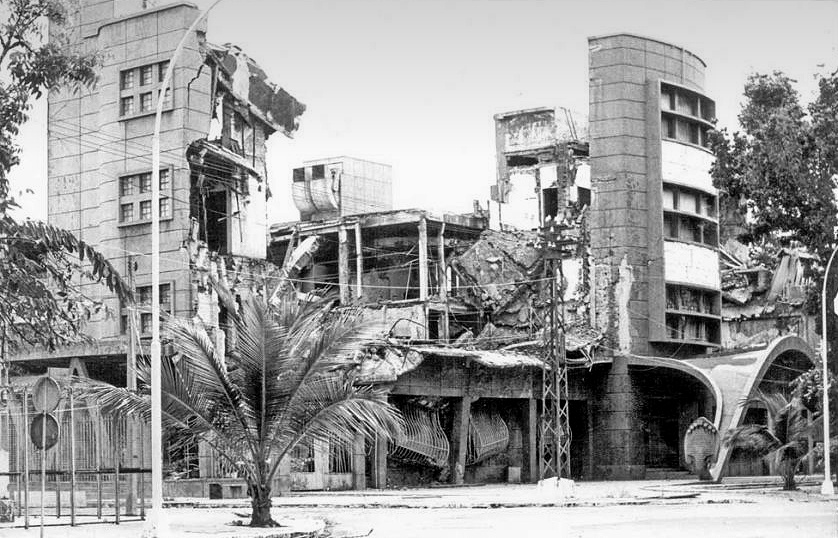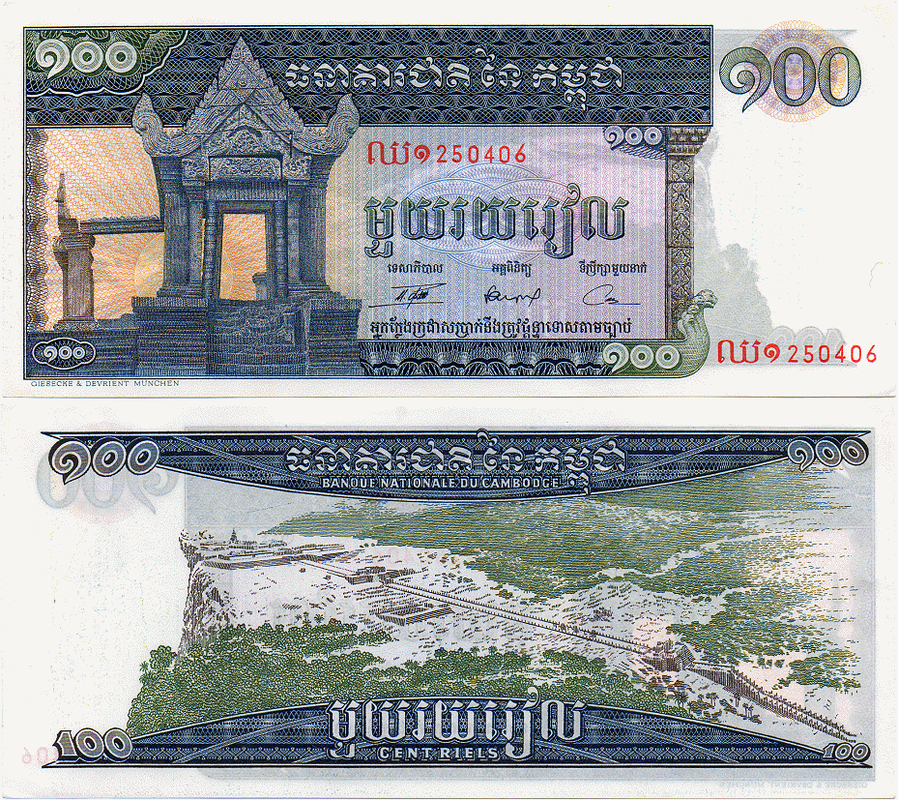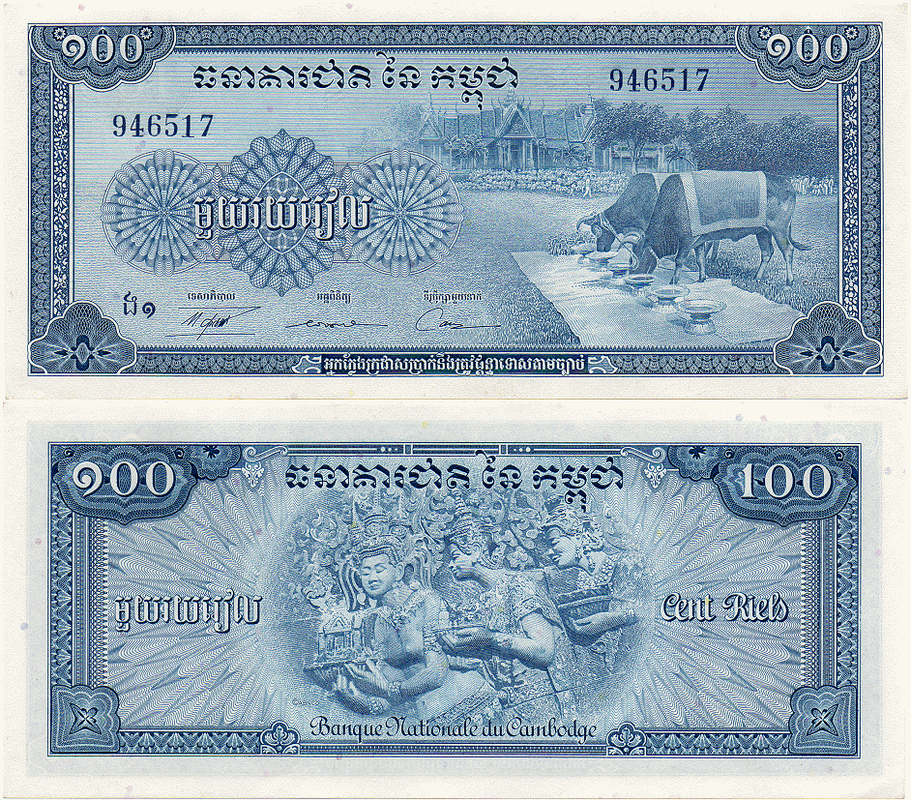new: October 31 2016
The Brief Currency of the Khmer Rouge |
|
Cambodia: a protectorate of France as part of French Indochina from 1863 until under the reign of King Norodom Sihanouk, Cambodia gained independence from France on November 9, 1953, establishing a constitutional monarchy which lasted until 1970. Though the king abdicated in 1955, he remained in effect the ruler until 1970, with the title of Prince.
His father was king from 1955 until his death in 1960. Political and economic difficulties came to a head with a coup in March 18 1970, and while overseas, Sihanouk was deposed by the National Assembly which resulted in the establishment of what would be the short lived Khmer Republic. Formally declared on October 9, 1970, the Khmer Republic was a right-wing pro-US military-led government headed by general Lon Nol and prince Sisowath Sirik Matak. The main causes of the coup were Norodom Sihanouk's toleration of North Vietnamese activity within Cambodia's borders, allowing heavily armed Vietnamese Communist outfits de facto control over vast areas of eastern Cambodia. Another important factor was the dire state of the Cambodian economy, an indirect result of Sihanouk's policies of pursuing neutrality through anti-Americanism. The Khmer Republic however was riven with problems. The new nationalist regime ended the covert co-operation between Cambodia and Northern Vietnam, choosing now to back South Vietnam instead. This inevitably led to greatly increased instability as the forces supporting the deposed Sihanouk joined with the emerging Khmer Rouge and North Vietnamese troops to oppose the republic. Within five years the Khmer Republic was swept away by the infamous Khmer Rouge (1975-79). |
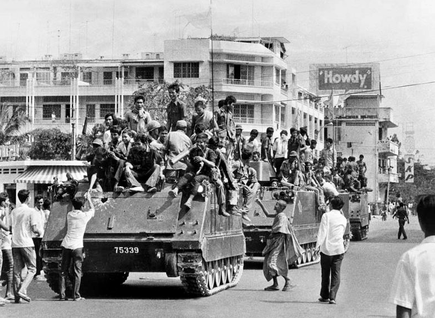
Bizarrely, Norodom Sihanouk was declared the titular head of state under the Khmer Rouge during 1975-76, a fact which was has blackened his name with many, though he resigned in protest allegedly in response to witnessing the forced labour and population displacement in the countryside. He then received an US$8000 per year pension from the government, which is more than odd in a supposedly 'moneyless' society. Unexpectedly, he ruled again as King from 1993 - 2004, though in a purely honorific role. Deceased as recently as 2012, he his claimed to have held more political offices than anyone else, alive or in history.
The Khmer Rouge took charge following years of bloody conflict, in April 1975. The establishment of Democrat Kampuchea was proclaimed 15 January 1976. Unfortunately for millions within Cambodia, this victory may have temporarily ended the warfare, but would only be the beginning to a gruesome end, as the new government turned on it's own people, massacring over a million people through forced labour and executions and causing the deaths of over a million more though famine and disease. The underlying reasons behind this extreme widespread violence are still being debated; certainly decades of violent regional warfare was a clear factor though by no means the only contributing one.
In addition to the human rights abuses, the legal system was effectively abolished, regional administration thrown into chaos and foreign relations were only maintained with China, North Korea and Vietnam - and were soon lost with the latter. Cities were emptied out, organised religion was abolished, and private property, money and markets were eliminated. The central bank was destroyed and a barter system replaced Cambodia's currencies.
Fortunately the beginning of the end of this regime came about when the Khmer Rouge turned on their former allies, the also recently victorious Vietnamese communists, and launched attacks within southern Vietnam over disputed territory. They also killed virtually all of the Vietnamese population of Cambodia (in addition to other ethnic minorities). Eventually the Vietnamese counter-attacked and invaded Cambodia, overthrowing the Khmer Rouge and establishing their own compliant government in 1979. The Khmer Rouge however survived for some time in regions of the country and even formed a government-in-exile which held on to Cambodia's seat at the UN until 1993. After this however the organisation rapidly diminished and effectively ceased to exist in 1999.
The Khmer Rouge took charge following years of bloody conflict, in April 1975. The establishment of Democrat Kampuchea was proclaimed 15 January 1976. Unfortunately for millions within Cambodia, this victory may have temporarily ended the warfare, but would only be the beginning to a gruesome end, as the new government turned on it's own people, massacring over a million people through forced labour and executions and causing the deaths of over a million more though famine and disease. The underlying reasons behind this extreme widespread violence are still being debated; certainly decades of violent regional warfare was a clear factor though by no means the only contributing one.
In addition to the human rights abuses, the legal system was effectively abolished, regional administration thrown into chaos and foreign relations were only maintained with China, North Korea and Vietnam - and were soon lost with the latter. Cities were emptied out, organised religion was abolished, and private property, money and markets were eliminated. The central bank was destroyed and a barter system replaced Cambodia's currencies.
Fortunately the beginning of the end of this regime came about when the Khmer Rouge turned on their former allies, the also recently victorious Vietnamese communists, and launched attacks within southern Vietnam over disputed territory. They also killed virtually all of the Vietnamese population of Cambodia (in addition to other ethnic minorities). Eventually the Vietnamese counter-attacked and invaded Cambodia, overthrowing the Khmer Rouge and establishing their own compliant government in 1979. The Khmer Rouge however survived for some time in regions of the country and even formed a government-in-exile which held on to Cambodia's seat at the UN until 1993. After this however the organisation rapidly diminished and effectively ceased to exist in 1999.
The Money: The Bank of Kampuchea
The Khmer Rouge introduced their short lived currency in limited regions for about two months in 1975, before altogether eradicating money within Cambodia, instituting a barter system in it's place. The National Bank of Cambodia headquarters was blown up shortly after they occupied the capital. Under their regime, all banks were closed and the use of money abolished.
It should be noted that journalist John Pilger had the impression that the bank was blown up as the Khmer Rouge retreated in 1979?
The currency was designed and printed in Shanghai by the Central Printing Factory and is in many ways similar to issues also printed for the Pathet Laos in 1968.
note: SCWPM: Standard Catalog of World Paper Money
It should be noted that journalist John Pilger had the impression that the bank was blown up as the Khmer Rouge retreated in 1979?
The currency was designed and printed in Shanghai by the Central Printing Factory and is in many ways similar to issues also printed for the Pathet Laos in 1968.
note: SCWPM: Standard Catalog of World Paper Money
Below: The National Bank of Cambodia in 1975, and it's ruins, taken in a photo of c.1979
|
5 Riels
Deep green on green with yellow. (front) ruins of Angkor Wat temples. (back): crew of people digging and moving debris. Watermark: trio of triangular temple or stupa structures (similar to Lao notes), at Angkor. Printer: Central Printing Factory - Shanghai Type 1 (SCWPM P21a) Type 2 - (SCWPM P21s) - specimen (rare) |
|
10 Riels
Red and brown on turquoise/yellow. (front) machine gun crew. (back): armed agricultural workers gathering rice. Watermark: trio of triangular temple or stupa structures (similar to Lao notes), at Angkor. Printer: Central Printing Factory - Shanghai Type 1 (SCWPM P22a) Type 2 - (SCWPM P22s) - specimen (rare) |
|
50 Riels
Purple on yellow/green. (front) farm labourers at work in rice paddies, with the Maitreya or Avaloketesavara sculptural-faces of Bayon, the Khmer temple at Angkor, at right. (back): weapon wielding (rocket launcher?) female Khmer soldiers defending a bank amidst rice paddies. Watermark: trio of triangular temple or stupa structures (similar to Lao notes), at Angkor. Printer: Central Printing Factory - Shanghai Type 1 (SCWPM P23a) Type 2 - (SCWPM P23s) - specimen (rare) |
|
100 Riels
Deep green on yellow/pink. (front) machinist and other factory workers at left, with palm tree. (back): farmers gathering rice. Watermark: trio of triangular temple or stupa structures (similar to Lao notes), at Angkor. Printer: Central Printing Factory - Shanghai Type 1 (SCWPM P24a) Type 2 - (SCWPM P24s) - specimen (rare) |
|
"When I arrived in Cambodia with Eric Piper we were met by many surreal sights. During the monsoon rain, the streets of Phnom Penh ran, literally, with money. Unused bank notes flowed from the ruined national bank, blown up by the Khmer Rouge as they retreated (?). Starving children tried to light fires with them, beneath pots of roots and leaves." John Pilger (Australian-UK journalist) Left: a Cambodian child clutching some of the many obsolete banknotes of the old Khmer Republic. Eric Piper 1979 |
Cambodia - Khmer Rouge zones issues 1993

In 1979, the Khmer Rouge were pushed out of Phnom Penh, but they still controlled some northern and western provinces until 1993, when large numbers of them surrendered. The last small groups finally surrendered in 1998.
During their control of these northern and western provinces, the Khmer Rouge issued a series of lithographed notes, in 1993. They were printed on an old printing press from a lottery ticket printer in Bangkok. The press was acquired and brought by the Thai military to the Khmer Rouge in Anlong Veah, Cambodia. The issue was withdrawn after a few years and ordered destroyed but some examples survive. Inevitably there are numerous fakes.
The notes carry the signature of Khieu Samphan: he succeeded Norodom Sihanouk as President and head of state of Kampuchea 1976-1979. He succeeded Pol Pot as the head of the Khmer Rouge in 1985, remaining as such until 1998. He is the second oldest surving senior member of the organisation; On 7 August 2014, he and Nuon Chea (former Prime Minister) finally received life sentences for crimes against humanity - though they are appealing the conviction.
Below: one way of detecting many modern fakes is by comparing the black text which on genuine examples is solid black. The fakes have the text dot printed, with fuzzy edges. Keep in mind that the printing and paper of these notes should appear similar to 1970s-1980s lottery tickets from the region. Source: stampboards.com
During their control of these northern and western provinces, the Khmer Rouge issued a series of lithographed notes, in 1993. They were printed on an old printing press from a lottery ticket printer in Bangkok. The press was acquired and brought by the Thai military to the Khmer Rouge in Anlong Veah, Cambodia. The issue was withdrawn after a few years and ordered destroyed but some examples survive. Inevitably there are numerous fakes.
The notes carry the signature of Khieu Samphan: he succeeded Norodom Sihanouk as President and head of state of Kampuchea 1976-1979. He succeeded Pol Pot as the head of the Khmer Rouge in 1985, remaining as such until 1998. He is the second oldest surving senior member of the organisation; On 7 August 2014, he and Nuon Chea (former Prime Minister) finally received life sentences for crimes against humanity - though they are appealing the conviction.
Below: one way of detecting many modern fakes is by comparing the black text which on genuine examples is solid black. The fakes have the text dot printed, with fuzzy edges. Keep in mind that the printing and paper of these notes should appear similar to 1970s-1980s lottery tickets from the region. Source: stampboards.com
The Money
|
5 Riels
Undated (known to have been issued/circulated from 1993-1999). Lithographed. Multicolour-photographic imagery. (front) Children harvesting vegetables at center, with temple carvings at left and right. Signature of President Khieu Samphan at the lower left. (Back): Caravan of ox carts at center, temple carvings at Printer: Khmer Rouge Type 1 (SCWPM R1) |
|
10 Riels
Undated (known to have been issued/circulated from 1993-1999). Lithographed. Multicolour-photographic imagery. (front) village huts with a field of crops, framed by temple carvings at left and right, with a large stylised statue of a lion at the right. Signature of President Khieu Samphan at the lower left. (Back): river scene with fishing boats, and sculptures at left and right. Printer: Khmer Rouge Type 1 (SCWPM R2) |
|
20 Riels
Undated (known to have been issued/circulated from 1993-1999). Lithographed. Multicolour-photographic imagery. (front) villagers leading cattle, framed by temple carvings at left and right. Signature of President Khieu Samphan at the lower right. (Back): a busy street scene overhung with trees, and sculptural details at left and right. Printer: Khmer Rouge Type 1 (SCWPM R3) |
|
50 Riels
Undated (known to have been issued/circulated from 1993-1999). Lithographed. Multicolour-photographic imagery. Serial on back. (front) ox drawn carts or ploughs, and sculptural details at left and right. Signature of President Khieu Samphan at the lower right. (Back): villagers planting rice, framed by temple carvings at left and right. Printer: Khmer Rouge Type 1 (SCWPM R4) |
|
100 Riels
Undated (known to have been issued/circulated from 1993-1999). Lithographed. Multicolour-photographic imagery. (front) field workers harvesting, and sculptural details at left including a lion. Signature of President Khieu Samphan at the lower right. (Back): the approach to Angkor Wat, framed by temple carvings at left - Maitreya or Avaloketesavara sculptural-faces of the Bayon temple of Angkor - and right. Printer: Khmer Rouge Type 1 (SCWPM R5) |

